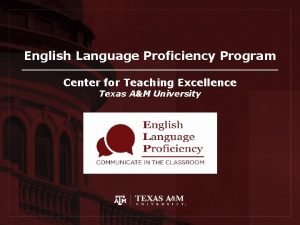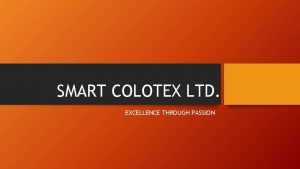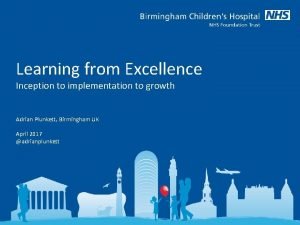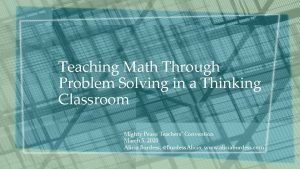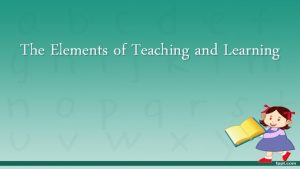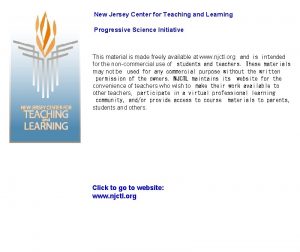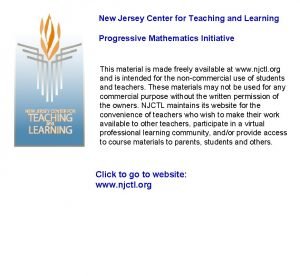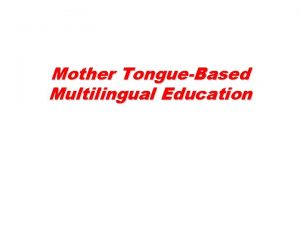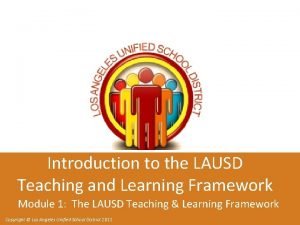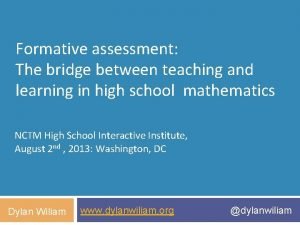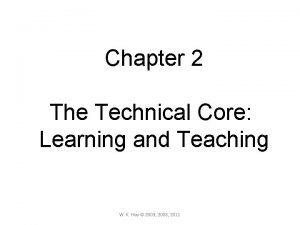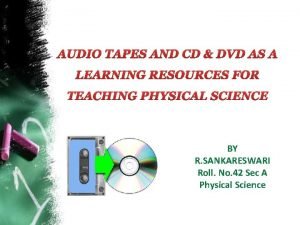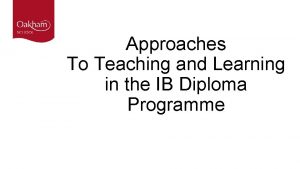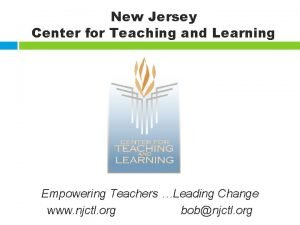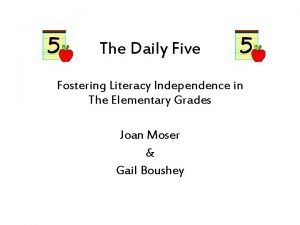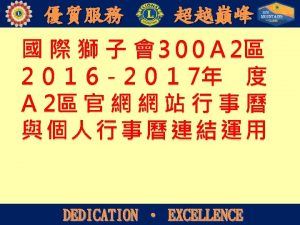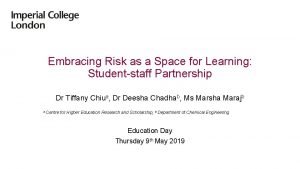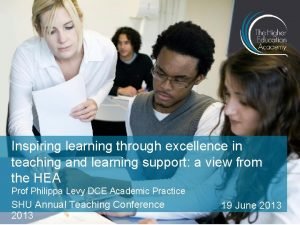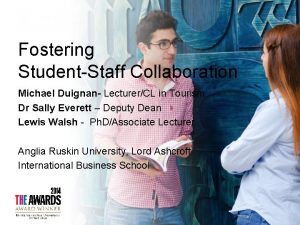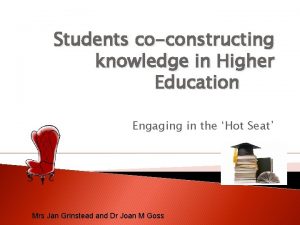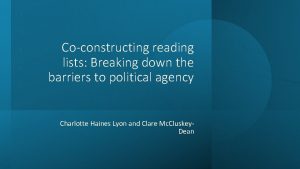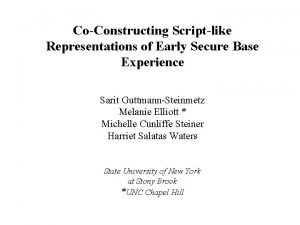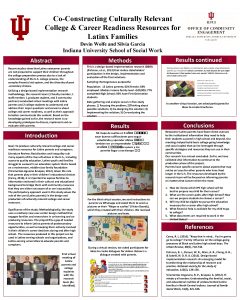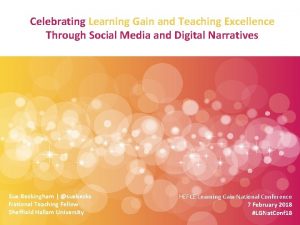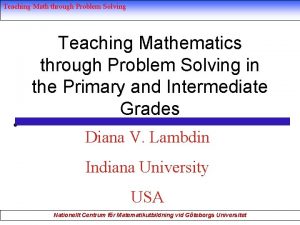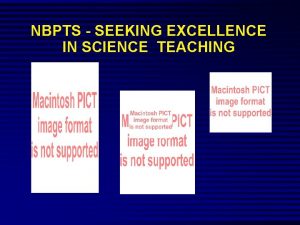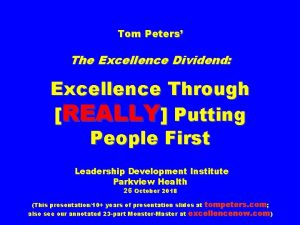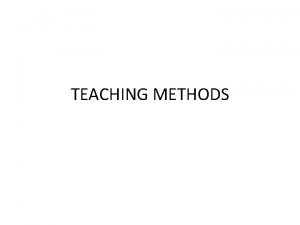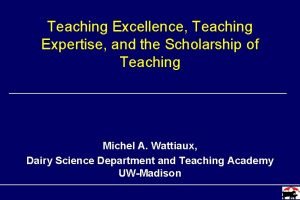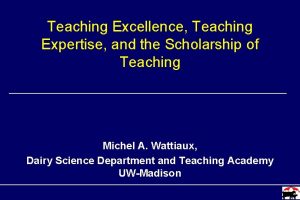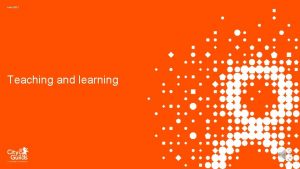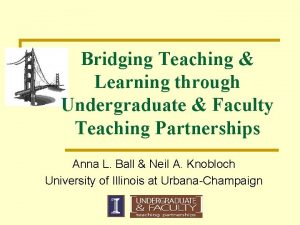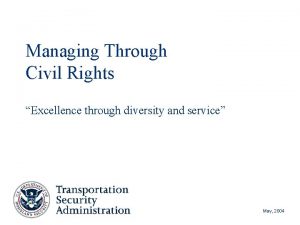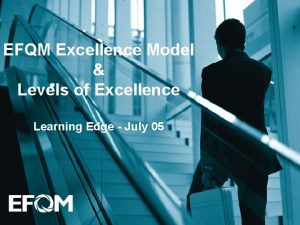Coconstructing Excellence in Learning and Teaching through StudentStaff





















- Slides: 21

Co-constructing Excellence in Learning and Teaching through Student-Staff Partnerships: Working with Resistance Ruth Healey Mick Healey r. healey@chester. ac. uk mhealey@glos. ac. uk Healey HE Consultants: www. mickhealey. co. uk “Partnership represents a sophisticated and effective approach to student engagement because it offers … the possibility for genuinely transformative learning experiences for all involved. ” (Healey et al. 2014, 7) “We should accept resistance as part of a natural sense-making process that allows us to think together about the complexity of genuine pedagogical partnership” (Matthews 2019, 1)

Structure A. Unpacking ‘excellence’ and ‘studentstaff partnership’ B. The role of resistance in student-staff partnerships C. Moving beyond student evaluations (experiences) of teaching

Co-constructing excellence with students Students working in partnership with staff Both are context dependent Excellence in learning and teaching

Excellence and nature of HE Excellence, best practice, and interesting practice Excellence varies over time and between national systems, HEIs, and disciplines Excellence of what, for whom, and to what ends? It is situated and sensitive to context

Exclusive to inclusive excellence Appears to be a move from emphasis on elitist views of excellence to ones emphasising opportunity of excellence for all Different forms of excellence can co-exist and have equal value However, ignores the stratified HE system and the inequalities in access to resources between institutions and individuals

Defining partnership Process by which students and staff work together to enhance learning and teaching in higher education. “Partnership is essentially a process of engagement, not a product. It is a way of doing things, rather than an outcome in itself. ” (Healey, Flint & Harrington 2014, 12)

Co-constructing excellence with students In pairs you each have ONE minute to tell the other of an example you are either familiar with or would like to see of: students and staff working together to co-construct excellence in learning and teaching in HE

Resistance to co-constructing excellence with students Among the key challenges to this type of work are: “Communicating partnership as a concept and overcoming resistance. ” (Mercer-Mapstone & Marie 2019: 24)

Partners in co-constructing excellence What resistance have you experienced to students and staff working in partnership? 3 mins

Approaches to working with resistance • The language used can evoke resistance - avoid a single definition/term (Healey M et al. 2014) • Discuss partnership values with people, identifying what is important to individuals rather than how to ‘label’ it

Partnership values Authenticity: the rationale for all parties to invest in partnership is meaningful and credible. Honesty: all parties are honest about what they can contribute to partnership and about where the boundaries of partnership lie. Inclusivity: there is equality of opportunity and any barriers (structural or cultural) that prevent engagement are challenged. Reciprocity: all parties have an interest in, and stand to benefit from working and/or learning in partnership. Empowerment: power is distributed appropriately and ways of working and learning promote healthy power dynamics. Trust: all parties take time to get to know one-another and can be confident they will be treated with respect and fairness. Courage: all parties are encouraged to critique and challenge practices, structures and approaches that undermine partnership, and are enabled to take risks to develop new ways of working and learning. Plurality: all parties recognise and value the unique talents, perspectives and experiences that individuals contribute to partnership. Responsibility: all parties share collective responsibility for the aims of the partnership, and individual responsibility for the contribution they make. Source: HEA (2015)

Approaches to working with resistance • The language used can evoke resistance - avoid a single definition/term (Healey M et al. 2014) • Discuss partnership values with people, identifying what is important to individuals rather than how to ‘label’ it • Focus on it being a process and not a product • Work together to make a partnership agreement • Partnership isn’t for everyone or everything – and that’s OK • Question it, explore it, challenge it yourselves e. g. should we be trying to scale up partnership practice? (Surrey Symposium, September 2019)

Partners in co-constructing excellence How might we approach working with resistance to co-construct excellence? Based on the example of students and staff working together to co-construct excellence in learning and teaching in HE that you shared your partner in the one minute exercise. How will you work with resistance to achieve that? 5 mins

Going beyond student evaluations (experiences) of teaching (SET) • Most institutions rely on decontextualized surveys of students for evaluating teaching. • By moving to ‘Reflective conversations about improving the learning process, … informed by evidence-based pedagogical principles and local (i. e. , contextualized) practice-based research, the prime driver of SET can be flipped from outputs to inputs for educational development’ (Roxå et al, in submission).

Going beyond student evaluations (experiences) of teaching (SET) “There is a subtle, but extremely important, difference between an institution that ‘listens’ to students and responds accordingly, and an institution that gives students the opportunity to explore areas that they believe to be significant, to recommend solutions and to bring about the required changes. ” (Dunne in Dunne and Zandstra, 2011, 4)

Co-constructing excellence with students If we are serious about developing excellence in higher education then we need to co-create learning and teaching with our students and we need to go beyond simply asking their opinions and engage with them as partners.

International Journal for Students as Partners (IJSa. P) • Research articles, case studies, opinion pieces, reflective essays and reviews • International editorial team of students and staff from Australia, Canada, Hong Kong, Malaysia, UK IJSa. P explores new perspectives, practices, and policies & US regarding how students and staff are working in partnership to enhance learning and teaching in higher education https: //mulpress. mcmaster. ca/ijsap

5 th Mc. Master International Sa. P Institute (ISa. PI) 20 -22 May 2020 in Hamilton, Ontario Where possible pairs of staff and students are invited to participate in a series of workshops OR Alternatively teams of 4 -6 faculty and students (at least two of each) from an institution(s) can apply to join a three-day ‘Change Institute’ Facilitated by an international team of experienced staff and students https: //macblog. mcmaster. ca/summer-institute/ Deadline for Change Institute is 24 Feb 2020; Early bird registration until 3 April 2020

Students as partners: A vision “ … it should be the norm, not the exception, that students are engaged as copartners and co-designers in all university and department learning and teaching initiatives, strategies and practices. ” (Healey, 2012)

Resistance and excellence “… where resistance is most pronounced, the potential for powerful and transformative learning and change is greatest. Support, sensitively and thoughtfully offered, is needed to build the capacity of both students and staff to work together effectively in partnership (Williamson 2013)” (Healey et al. 2014, 21).

 Teaching excellence and achievement
Teaching excellence and achievement Center for teaching excellence tamu
Center for teaching excellence tamu Excellence through passion
Excellence through passion Learning from excellence
Learning from excellence Disadvantages of timber conversion
Disadvantages of timber conversion Scaled down teaching
Scaled down teaching Cuadro comparativo e-learning m-learning b-learning
Cuadro comparativo e-learning m-learning b-learning Sin entered through one man
Sin entered through one man Furcation
Furcation Night of the scorpion summary
Night of the scorpion summary Alicia burdess teaching through problem solving
Alicia burdess teaching through problem solving Cognitive and appetitive faculties of the learner
Cognitive and appetitive faculties of the learner New jersey center for teaching and learning
New jersey center for teaching and learning How many total squares are there
How many total squares are there Guiding principles of mtb-mle
Guiding principles of mtb-mle Teaching and learning framework lausd
Teaching and learning framework lausd Assessment: the bridge between teaching and learning
Assessment: the bridge between teaching and learning Technical core meaning
Technical core meaning Importance of tape recorder in education
Importance of tape recorder in education Approaches to teaching ib
Approaches to teaching ib Www.njctl.org answer key
Www.njctl.org answer key 10 steps to independence daily 5
10 steps to independence daily 5

